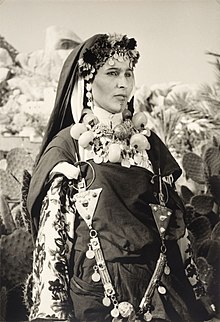Prior to the spread of Islam into Morocco, which brought along with it the Arab conquest, Morocco was part of a region inhabited mostly by a non-Arab Amazigh population.Various Amazigh tribes during the 4th, 5th, and 6th century were noted to have been matrilineal, such as the Tuareg tribes of North Africa. As such, Amazigh women were noted to have taken on significant roles in local communities. This was especially evident through the figure of Kahina, who was a noted Amazigh female military leader who fought against the Arab and Muslim expansion into North Africa.
As part of a broader French imperialist project that justified the colonization of Morocco and the Maghreb region in general, European narratives on Moroccan women were fixated on Orientalist images. Dominant narratives described Moroccan women as docile, oppressed, and in need of being saved. Consequently, Moroccan women’s experience of life under colonialism was a result of multiple intersections of power and patriarchy. For example, following a growing trend of French land expropriation, which drove rural Moroccan families out of their homes and land, many Moroccan women migrated to the urban areas in search of economic opportunity, especially in Casablanca.Upon migrating to Casablanca, many Moroccan women were forced into prostitution, namely due to their lack of formal identification documents—a policy that the French instituted.
Just as Moroccan women were subject to a gendered form of colonialism, their resistance was gendered as well. The oral traditions of Moroccan women were a unique form of disseminating stories of resistance, oftentimes inspired by existing Islamic oral traditions of female warriors who fought in early Islamic history, such as the stories of Hind and Sukayna. Moroccan women, especially those involved in the armed resistance primarily in the northern Rif region, adopted their own experiences of fighting against colonialism to existing frameworks of oral traditions that address women in war. The storytelling of these events played a significant role in shaping memories and conceptualizing post-colonial identities among women.
In addition to the oral traditions of women involved in armed resistance, a role that mostly lower class women took up, upper class Moroccan women were heavily involved in the nationalist politics of resisting colonialism. The Istiqlal Party was the primary mobilizing political force in Morocco that rallied against French colonial rule. The party included the participation of various elite Moroccan women from wealthy and educated families, such as Malika Al-Fassi, from the still influential Al-Fassi family.There was a close collaboration between women like Malika Al-Fassi, who were important figures in the political resistance, and women such as Fatima Roudania, a working-class armed resistance fighter. The wealthier women involved with the Istiqlal Party provided educational services to lower class women involved in the armed resistance, assisted in the proliferation of nationalist literature and knowledge production, and provided protection by hiding women who were fighting against the French.
Many of the Moroccan women involved in resisting French colonialism oftentimes looked to the public presence of women in other struggles of resistance in the region for inspiration, such as in Algeria and Palestine, including women like Djamila Bouhired and Leila Khaled.
Amazigh women have had a lasting position in Moroccan folklore, a position that predates the Arab and Muslim conquest of the Maghreb region. It is believed that the tale of Aisha Qandisha has existed since at least the 7th century.[6] There are several variations of Aisha Qandisha’s name, among which include Lalla Aicha and Aicha Hamdouchia. Stemming from the pre-Islamic era of Morocco, Aisha Qandisha is said to have been a female demon that takes the shape of multiple beings, including a half-goat.Aicha Qandisha, unlike other demons in Moroccan folklore, appears mostly in men’s dreams and is said to make a man impotent. Such folklore remains widely popular in Morocco today.
morocco culture,moroccan food,morocco food,moroccan cuisine,morocco beaches,moroccan meal,beaches in morocco,moroccan culture,hercules cave,hercules cave morocco

